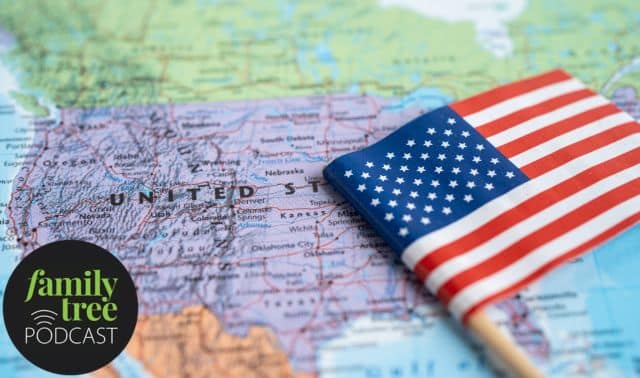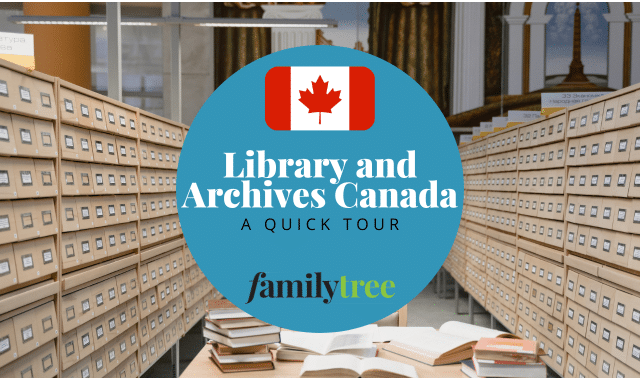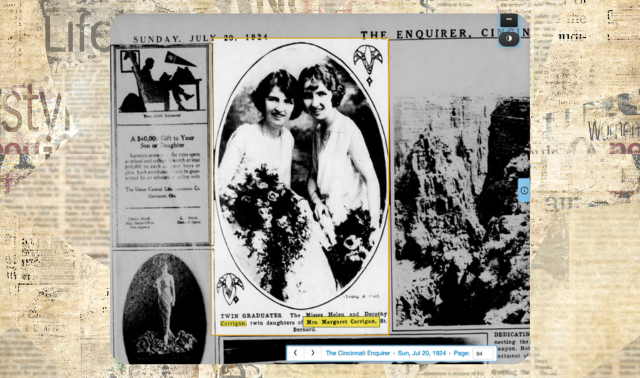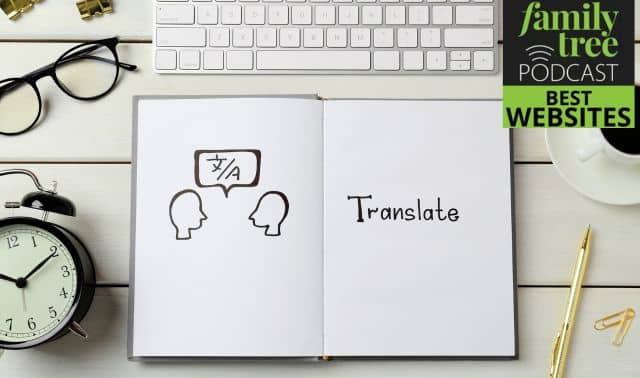When crime fighters reconstruct a crime, they gather as much information as possible about the villain. Witnesses are interviewed and forensic evidence gathered. An artist may even be called in to create a sketch from facts investigators have gleaned: height, weight, skin tone, facial features and notable physical characteristics, such as eyeglasses or a limp.
We can create similar composite sketches of our ancestors. Documents from the past hold eyewitness testimony from government workers, family members and our ancestors themselves. Some of these sources even contain photographs. You just need to know how to ferret out the right sources of physical descriptions, glean the details and combine them to create an image in your mind’s eye and in your family history book.
This list of 10 eyewitness sources will help you flesh out your composite sketch of your illustrious—or at least illustrated—ancestors.
1. Family sources
People and their memorabilia are my favorite sources for photographs and physical descriptions. Not just older relatives, but also their spouses or widows, my own siblings and cousins, and more-distant relations, too. I’ve often been surprised at who ends up with (but never mentions having) the family photo albums, portraits and shoeboxes full of memorabilia. The wider I spread my search, the better my chances at finding old pictures. My favorite find came from a second cousin, who shared the only photo we have of my husband’s great-grandfather.
Look to your relatives for recollections, too. Family memory is a powerful and underappreciated genealogy resource. Ask an 80-year-old relative how her 60-year-old grandfather looked when she last saw him as a 10-year-old child. Her description would likely be limited, but she might recall his dark skin, stooped posture, curly gray hair and rimmed glasses. That mental image would date from around 1942, and describe a man born around 130 years ago.
After you ask what a particular person looked like, follow up with more questions. “Did he get around well?” might prompt a memory of a limp, a cane or a jaunty stride. “What do you recall about her face?” might jog a recollection of sad eyes, laugh lines, a pirate beard or a perfect nose. Ask about gestures or quirky habits: You might discover a sudden memory of great-aunt Valeria’s perpetual squint or the way she talked with her hands. Ask if your relative ever saw pictures of that person, and could she describe what she recalls.
Don’t forget to show your old photos and ask about the people pictured. Someone may comment that Grandpa had not yet lost his hair, or might be able to pick out her grandmother from a group. An older relative helped me identify a great-grandfather and his brother from a panoramic image of their coal mining community. When a relative is identified in a group photo, immediately make a photocopy of the picture. On the copy, circle the person, write her name, and jot down who identified her and when. Otherwise you’ll likely forget your great-aunt was on the third row, fifth from the center.
2. Newspapers
Especially during the 1900s, newspapers often “featured photos of local business people, recent graduates, military enlistees, engaged couples, newlyweds, community organizations, church and family gatherings, athletic teams and newsworthy individuals,” says Cheryl Felix McClellan, a library staff genealogist in Chardon, Ohio. She recommends checking dates such as 50th anniversaries, high school graduations or the week after a relative’s death. Don’t neglect ethnic newspapers, which you might find in local or ethnic repositories (including the Immigration History Research Center).
Digitized newspaper collections make it even easier to find photos and descriptions with full-text searches, which capture information even in photo captions. Before telephones, immigrants and on-the-move laborers often placed newspaper ads to search for relatives and friends. It’s common to find a valuable physical description in these tiny ads.
There’s a handy list of free and paid newspaper collections by state at
en.wikipedia.org/wiki/Wikipedia:List_of_online_newspaper_archives#United_States. Free digital collections like the Library of Congress’
Chronicling America are good starting points. State and university libraries also may offer free databases. See if your library offers ProQuest Historical Newspapers, which covers news back to 1764. Subscription sites
GenealogyBank and
Newspaper Archive boast tens of millions of newspaper pages dating back centuries. See more online newspaper sources in the November 2011
Family Tree Magazine. Check with each site regarding copyright if you want to publish images you find.
3.School records
“Yearbooks and school photos provide more than just a glimpse at how an ancestor looked in high school or college,” says Teri Brown, owner of two websites for collecting and sharing heritage photos. “You can get an idea of your ancestor’s character: Class president, class clown, most beautiful.”
Brown’s
Old-Yearbooks.com site posts yearbooks from around the United States, plus links to other yearbook and school photograph sources. She reminds researchers to look for loose class photos as well as yearbooks: “Many schools took class photos long before they published a yearbook.” Check
FamilyOldPhotos.com for group class, club and team photos.
Subscription site
E-Yearbook offers search, browsing and printing of millions of high-resolution photos from middle and high school, college and military yearbooks.
Don’s List lets you search indexes and images for an estimated 4,000 yearbooks dating to the 1880s. Ancestry.com also has an impressive collection. And it’s worth checking auction sites such as
eBay and online booksellers such as
Amazon.com for yearbooks from your ancestor’s school.
Look in a yearbook’s hometown for past editions, too. High school and university archives, alumni associations, administrative offices or current yearbook staff may have old annuals. (Cleveland’s Case Western Reserve University even has
digitized yearbooks.) Local libraries also may have school memorabilia: The Geauga County, Ohio, public library has boxes of school photos, graduation programs and articles about local schools.
4.County histories
Longtime genealogist Paula Shepherd loves county histories for 19th-century research. “[They’re] a treasure trove of family information and pictures,” she says. “They were dubbed ‘mug’ books because of the pictures. County residents were invited to enter information on their family and pioneer heritage.”
Shepherd cautions that the “facts” you find in these histories may be embellished, as some families exaggerated their importance. But “the pictures in county histories tend to be of a high quality, usually posed portraits taken in a studio, probably processed from original glass negatives or daguerreotypes.”
Find county histories at local repositories and in major genealogical libraries. Many are also available for free full-text searching at
Google Books and the
Family History Archive. Try entering the county and state names as search terms, along with the phrase county history. Full-text searching helps when a book isn’t indexed, biographical entries aren’t alphabetical, or your ancestor’s name appears in an unexpected place (say, the caption of a school board photograph). Image quality won’t be as good for photos captured online, but you can always track down a print version.
5. Funeral home records
This might seem a surprising source for your composite sketch. “The first descriptive record I ever got that struck me as a really lucky find was a funeral home record, which included the embalmer’s records,” avid family historian Cynthia Turk says. “It was for my great-great-grandfather, for whom I had no photo. The record included some gory details, but it was a delight to find him described.” Turk learned her ancestor was 5’6”, weighed 140 pounds, with blue eyes, grey hair and beard, and bad teeth. “When I finally inherited the only known picture of him, he was pretty much as I had imagined.”
Embalmers’ notes are just one type of physical description you might find in funeral home records. Photos may appear on 20th-century mourning cards or funeral programs, a sample of which the funeral home may have kept on file. The deceased’s height and weight may be recorded relative to the purchase of a coffin or cremation services. Notes may indicate the coroner’s office did an autopsy, pointing you toward additional records.
Determine what funeral home may have served your family using obituaries, death certificates and cemetery records. No luck? Check city directories for funeral homes operating near the place of death. A phone book, the internet or the American Blue Book of Funeral Directors can help you learn whether the home is still in business. Inquire about records by phone, with an offer to reimburse staff for time, photocopies and postage. If you can’t find the home or they can’t help you, search online with the name of the city and funeral home and the phrase funeral records. Check with local genealogical and historical libraries, too.
6. Draft registration cards
Millions of men had to register for the draft in both world wars. Three successive versions of the WWI draft registration card requested basic physical details: height (tall, medium or short); build (slender, medium or stout), eye and hair color, and whether the applicant was missing a limb or otherwise visibly “physically disqualified.” WWII draft cards requested more detail. The registrar estimated height and weight, selected a complexion (sallow, light, ruddy, dark, freckled, light brown, dark brown or black), and noted “other obvious physical characteristics that will aid in identification.”
The first clues I found to my husband’s great-grandfather’s appearance are in his draft registration cards. In 1917, Andrew O’Hotnicky’s card describes him as short and stout, with gray eyes and black hair. In 1942, the registrar indicates Andrew was 5’7” and 190 pounds with blue eyes, brown hair and a dark complexion, and he wore glasses.
7.Military service and pension records
Military records can add to your composite sketch of your ancestor, especially if he claims a disability. My own ancestor Samuel McGahey applied for a pension after the Civil War. His 1887 application tells me he was 5’8”, with a light complexion, auburn hair and blue eyes. He also had untreated “piles [hemorrhoids] from which he never recovered.” In 1892, another application gives more-specific (and creatively spelled) physical details: “piles, dislocated rist wright knee Cap dislocating the grate toe damaged. Dispepsey. Skull cracked. Wright lung damaged, dimness of sight. Shortness of memory.”
How you’ll locate and access military records varies based on dates and type (state or federal, volunteer or regular) of service, military branch and rank. Consult a guide such Family Tree Magazine’s Military Research Guide: Tracing Ancestors in America’s Wars CD, or Tracing Your Civil War Ancestor by Bertram H. Groene. Generally, you’ll order copies of original pension applications and compiled military service files for most federal volunteers who served before 1917 from the National Archives and Records Administration’s (NARA) Order Online service for $25 to $75.
You can find indexes to pension records and even some digitized records at sites such as Ancestry.com,
Fold3 and FamilySearch.org.
8. Naturalization papers
Citizenship documents can usually tell you in words and pictures what your ancestor looked like. Both steps involved in applying for naturalization—the Declaration of Intention and the Petition for Naturalization—may contain physical descriptors. After 1929, they also include photos. Until 1922, a married woman took her husband’ citizenship status, so you’d find her name, but not her description, on his form.
What kinds of physical descriptions will you find? A 1927 Declaration of Intention for Canadian pharmacist Conrad George Smith describes him as 5 feet 7 inches, 145 pounds, with fair skin, dark brown hair, gray eyes and no distinctive marks. A “distinctive mark” might be a missing limb, eyeglasses, facial hair, prominent scar or birthmark.
Until 1906, there’s no central repository for naturalization papers because they could be filed in almost any court. Some indexes and records are on Ancestry.com, Fold3 and FamilySearch.org, and papers filed in federal courts are on microfilm at the FHL and NARA facilities. You can request 1906 and later citizenship papers (including the alien registrations required of noncitizens in 1940, which mentioned height, weight, and hair and eye color) via Citizenship and Immigration Services
www.uscis.gov/genealogy. Request an index search for $20 or copies for $20 to $35.
9. Passport applications
Passports were required for traveling abroad early in the Civil War (1861-1862), during World War I (1918-1921), and from World War II (1941) forward, but Americans could apply for them as early as 1789. All except the earliest passport applications request physical descriptions; photos were added in December 1914.
These documents often are quite detailed, and you may find multiple applications. Wealthy Cleveland industrialist W.S. Tyler applied for four passports between 1895 and 1907. The first gives a striking description: “5’10½” tall, broad and high forehead, blue eyes, straight nose, medium mouth, long square chin, gray hair, florid complexion and long, narrow face.” Later, the description changed. His complexion was “fair” instead of “florid.” At age 68, he sported a small mustache and “side beard;” he still had the mustache (no mention of a beard) when he applied again four years later.
You can view digitized images of US passport applications at Ancestry.com (1795-1925) and Fold3 (1795-1905). The original applications are on file at NARA; many are on microfilm at its regional facilities. The FHL also has the microfilm.
10. Heritage photo collections
Almost every research repository has a photo archive, and massive digital image collections are searchable online. Published collections of photographs await you on library bookshelves and on Amazon.com’s virtual shelves . You never know what portraits or group photos you may uncover: your ancestor’s grade school, minor league baseball team, sewing club, church or company picnic, or military unit. I never thought my husband’s great-grandfather would appear in a book, but there’s his photo in West Virginia Panoramic Coal Field Photography: 1900-2005 by Melody Bragg (GEM Publications).
First, look for photo collections in the catalogs and websites of archives, libraries and societies. The Wyoming State Archives, for example, has a half-million images in its Historic Photograph Collection. You even may find digital photo archives, such as the Denver Public Library’s 120,000-image Western History/Genealogy Digital Collections. On Cyndi’s List, browse the Photographs & Memories—Photo Archives, Collections and Libraries category.
On Teri Brown’s free FamilyOldPhotos.com, you can search 24,000-plus images of people and places, add your own ancestral photos and network with other researchers. (Check out the railroad, circus, and fire department photos if these topics figure into your family history.) Similar features are available at
Dead Fred, which boasts more than 100,000 images.
Published collections of old photographs might focus on communities, ethnicities, organizations, the military and more.
Arcadia Publishing offers American community pictorial histories, as well as series on the histories of railroading, sports, businesses and more. When you search Arcadia’s website by ZIP code, you might find books filled with images of ethnic neighborhoods, riverfront or lakefront communities, coal miners, state hospitals or rural farmlands. Search library card catalogs and Amazon.com for other pictorial histories.
Images and physical descriptions aren’t always easy to find. We follow dead-end leads and sift out misinformation. Composite sketches sometimes have to be erased and re-sketched as new information emerges. But every image I’ve found—visual or in words—adds something valuable to my mental image of each ancestor. Samuel McGahey, my hemorrhoid-suffering Civil War ancestor, isn’t just another stair-step up the pedigree chart anymore: He’s a blue-eyed, red-headed Irishman who stood four inches taller than I do. A distant cousin of mine expressed an even more personal connection to Samuel. “Some of us still look like that,” she said. “We’re fish-belly white with bright red hair.” Now there’s a physical description worth sketching.
Tips:
- When you search auction sites for your last name and genealogy, be sure to also look for the common misspelling geneology.
- Run a Google Image search for your ancestor’s name, hometown, church, school, employer and groups he belonged to.
More Online
Free Web Content
For Plus Members
Family Tree Shop




